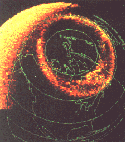
Auroral ImagingThe most spectacular view however is from space, where large areas of aurora can be observed simultaneously, even the entire polar cap. Spacecraft can carry very sensitive cameras, and they often use filters to observe the aurora in selected wavelengths, which cuts down interference from scattered sunlight. Such pictures often show a continuous ring of aurora around the polar cap (picture above), caused mostly by electrons leaking out along magnetic field lines, from the plasma sheet of the Earth's magnetic tail. This is the "diffuse aurora", first identified in 1972 by the Canadian ISIS-2 satellite: being diffuse and spread out, it is not conspicuous to observers on the ground. Since then, many spacecraft have taken pictures of the aurora from above, including the US satellites Dynamics Explorer 1 (DE-1) and Polar Bear, also the two Swedish spacecraft Viking and Freja. In addition, US Air Force satellites of the DMSP series, carrying auroral imagers for military purposes, collected images of auroral arcs as early as 1968. Three auroral imaging cameras (one using x-rays) are now flying aboard NASA's "Polar", launched on February 24, 1996, and more imagers are planned.
Acceleration of Auroral ElectronsEarly researchers thought such electrons originated far away (Birkeland believed they came from the Sun). Observations in the early 1970s however led David Evans (NOAA, Boulder) and others to conclude that their acceleration took place quite close to Earth, at distances of about one Earth radius (1 RE, 6371 km or some 4000 miles) or less. The clincher came in 1976 when the US Air Force satellite S3-3 (peak altitude 8040 km) detected narrow beams of fast oxygen O+ ions rising upwards towards the spacecraft. Any voltage which accelerated negative electrons downwards would also pull up positive ions, and the fact that S3-3 observed such ions at an altitude of 1 RE or so suggested that the process happened closer to Earth than that. How, and why? Because electrons and ions can slide along field lines like beads, one would expect that any time a voltage difference was created along a field line, particles accelerated by it would quickly slide and cancel the voltage, stopping the process. Hannes Alfven of Sweden (Nobel prize, 1970) and his associate Hans Persson, however, figured out that under proper conditions, the "mirror force" repelling trapped particles from regions of stronger magnetic field could balance this tendency to wipe out all voltage differences. Because the magnetic field is most intense near Earth, the repulsion is strongest there too, and the voltage drop balanced by it turns out to be strongest there as well. The preceding however is not enough. Because the acceleration process adds to the energy of ions and electrons, its energy must be constantly replenished, otherwise it soon runs out. It turns out that accelerated electrons usually form part of the circuit of Birkeland currents: whatever drives those currents probably also supplies the energy. Any electric current, like water in a pipe, needs to flow continuously, without interruption. If electrons are the main carriers of Birkeland currents (as observations suggest), they face an obstacle when they try to flow from space towards Earth: they must overcome the repelling "mirror force" which turns back all but a few before they can reach the ionosphere. An accelerating voltage can help the electrons overcome this obstacle, and the circuit can provide it, by reducing the voltage driving other parts of the current across the ionosphere, shifting part of the voltage so that it appears along the magnetic field lines.
The Polar CapsHowever, a thin drizzle of energetic electrons, called "polar rain" and observed in the dark regions, suggests that ultimately those lines are connected to the interplanetry magnetic field (IMF). The lines of the IMF near Earth, at any time, can be directed either away from the Sun or towards it. If some of these lines were somehow connected to the polar caps of the Earth, either the southern polar cap or the northern one would have field lines leading to the Sun, while field lines from the other cap would lead into deep space, away from the Sun. Satellites have found that the cap which was expected to be connected to the Sun also received a much stronger "rain" of electrons, suggesting that the lines were in fact linked, and that the polar rain came from the Sun.
Polar OrbitsThe Earth's rotation around its axis causes it to bulge slightly at its equator. A satellite's orbit usually lies in a flat plane, and the gravity pull of the bulge will tend to rotate that plane slowly around the Earth. A polar orbit passing exactly above the pole, however, is symmetric with respect to the bulge, and does not rotate. The twin Dynamics Explorer Satellites, launched in 1981, had two quite different orbits, but since both were launched in the same plane which passed above the pole, their orbits shared that plane throughout their mission. As the Earth goes around the Sun, the orientation relative to the Sun of such an "exactly polar" orbit will slowly rotate (though the orbit stays fixed relative to the distant stars). A satellite which starts in the noon-midnight plane will three months later be in the dawn-dusk plane. Low altitude polar satellites can stop this rotation by using a "sun-synchronous" orbit tilted a few degrees off the pole: the Earth's bulge then rotates the orbit at a rate which is just right for keeping it in the same position relative to the Sun.
|
 More about auroral imagers
More about auroral imagers More about auroral acceleration
More about auroral acceleration More about the polar caps
More about the polar caps More about polar orbits
More about polar orbits